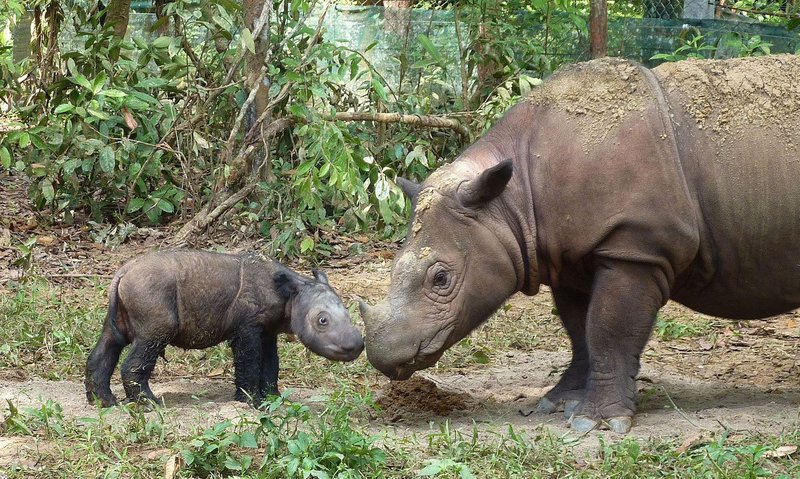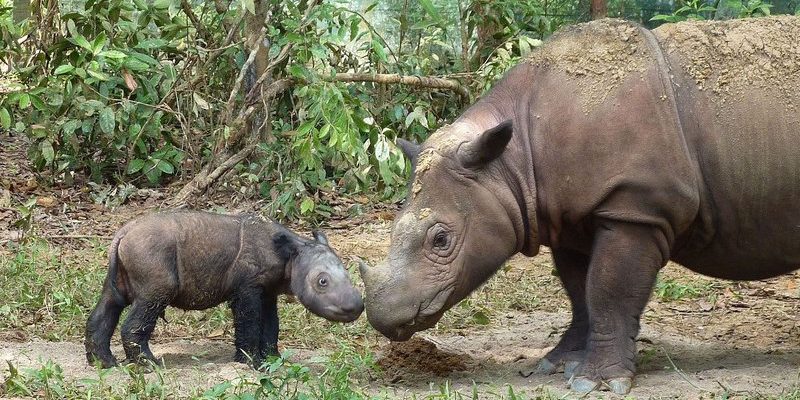
With fewer than 80 individuals left in the wild, the Sumatran rhino is the most endangered of all rhinoceros species. Its gradual decline is mainly due to habitat loss and poaching. Imagine trying to hide in a forest that’s shrinking around you—this is the reality for the Sumatran rhino. But there’s hope! Various organizations and dedicated individuals are working tirelessly to ensure that this unique species doesn’t vanish forever. In this article, we’ll explore what makes the Sumatran rhino so special, the reasons behind its endangered status, and what’s being done to protect these gentle giants.
Understanding the Sumatran Rhinoceros
The Sumatran rhinoceros, also known as *Dicerorhinus sumatrensis*, is the smallest of the living rhinoceroses and the only Asian species with two horns. It has a distinctive appearance, with a shaggy coat of hair that sets it apart from its more robust, hairless cousins like the white rhinoceros. Think of it as the quirky cousin at a family reunion—different but still adored.
These rhinos prefer dense, tropical forests where they can forage for food and escape from potential threats. With a diet primarily consisting of leaves, fruits, and shrubs, they play a vital role in their ecosystem by influencing plant growth. However, their elusive nature makes them difficult to study, and many aspects of their behavior and habitat needs remain a mystery. What we do know is that they are generally solitary creatures, coming together only to breed.
When it comes to their reproduction, Sumatran rhinoceroses have a long gestation period of about 15 to 16 months, which means that their population cannot bounce back quickly. This slow reproductive rate, coupled with the loss of their natural habitat, has been a recipe for disaster. Unfortunately, these creatures are often seen as an afterthought, tucked away in remote forests while the world focuses on more popular wildlife.
Why Is the Sumatran Rhinoceros Endangered?
You might be wondering what exactly has pushed the Sumatran rhinoceros to the brink of extinction. Let’s break down the main factors:
- Habitat Loss: Deforestation is a significant threat to the Sumatran rhino. As forests are cleared for agriculture, logging, and urban development, these mammals lose their homes and food sources. Imagine being forced out of your house and having nowhere to go—that’s the situation for these rhinos.
- Poaching: Unfortunately, the Sumatran rhino is targeted by poachers for its horn, which is believed to have medicinal properties in some cultures. The high demand for rhino horn has led to a dangerous black market. The notion that their horns hold magical healing qualities is as misguided as thinking that unicorns exist.
- Low Genetic Diversity: With such a small population, inbreeding has become a concern. This lack of genetic diversity makes them more susceptible to diseases and reduces their ability to adapt to changes in their environment.
The combined effects of these threats create a challenging scenario for the Sumatran rhinoceros, prompting urgent conservation action. The reality is stark: if we don’t act now, we might lose them forever.
Conservation Efforts to Save the Sumatran Rhinoceros
Here’s the thing: while the situation seems dire, many dedicated organizations and individuals are fighting to protect the Sumatran rhinoceros. Conservation efforts are aimed at addressing both habitat loss and poaching. Let’s take a look at some of the initiatives currently in action.
One of the most critical steps has been establishing protected areas where these rhinos can live without the threat of poaching or habitat destruction. National parks in Indonesia, like Bukit Barisan Selatan and Way Kambas, serve as sanctuaries for the remaining Sumatran rhinoceros population. These preserves help protect their natural habitat and allow them to roam freely. Imagine having a safe space to call home—this is exactly what these rhinos need to thrive.
Additionally, there are breeding programs in place that aim to increase the population. By bringing together rhinos from different regions, conservationists hope to boost genetic diversity and improve the chances of successful offspring. These programs often operate in controlled environments, allowing rhinos to breed safely away from poachers. It’s like setting them up on a date—helping them find a mate while ensuring their safety.
Furthermore, there is a strong emphasis on education and raising awareness. Many organizations are working to educate local communities about the importance of protecting the Sumatran rhinoceros and their habitat. Through workshops and outreach programs, people are learning that preserving these majestic creatures benefits not just the rhinos but also their local ecosystems and livelihoods. When communities understand their role in conservation, they become powerful allies in the fight against extinction.
The Role of Local Communities in Conservation
Local communities play a crucial role in conservation efforts for the Sumatran rhinoceros. After all, these folks live closest to the wildlife and often have valuable insights into their behaviors and habitats. When communities are involved, conservation becomes a team effort.
Engaging local populations helps build a sense of ownership over conservation efforts. Programs that benefit the community—like eco-tourism or sustainable agriculture—can provide alternative income sources that reduce reliance on poaching or habitat destruction. For example, if a community finds that they can earn money by offering guided tours to see wildlife, they may be less likely to resort to poaching.
Moreover, local knowledge can be crucial in tracking rhino populations and monitoring their health. By working with communities, conservationists can gather data that helps inform future efforts. For instance, if a local farmer reports seeing rhinos in a particular area, conservationists can prioritize that habitat for protection and further research.
It’s clear that when local communities are empowered and educated, they can become the strongest advocates for wildlife conservation. They hold the keys to protecting not only the Sumatran rhino but also the entire ecosystem they inhabit.
Success Stories in Sumatran Rhino Conservation
Amidst the challenges, there have been inspiring success stories in Sumatran rhino conservation. These tales of hope show that when dedicated people come together, real change can happen.
One remarkable example is the case of a Sumatran rhino named *Ratu*, who was brought to a breeding center in 2000 after being rescued from poachers. Ratu has since given birth to several calves, demonstrating that breeding programs can work. Each successful birth is a victory in the fight against extinction, offering a glimmer of hope for the species.
Another success comes from the collaborative efforts between various conservation organizations and governments. For instance, the Sumatran Rhino Rescue initiative focuses on both immediate and long-term solutions. By pooling resources and expertise, these groups can implement effective strategies to protect rhinos and their habitats.
These success stories remind us that despite the difficulties, progress is possible. With continued efforts and support, the Sumatran rhinoceros has the potential to bounce back—if only we keep working together.
What You Can Do to Help
Feeling inspired yet? You might be wondering what role you can play in aiding the conservation of the Sumatran rhinoceros. Fortunately, there are several ways to contribute, no matter where you are in the world.
- Support Conservation Organizations: Donating to reputable wildlife conservation organizations can make a huge difference. These groups often rely on funds to carry out essential work, from habitat preservation to anti-poaching initiatives.
- Raise Awareness: Spread the word about the plight of the Sumatran rhinoceros. Whether it’s sharing information on social media, hosting events, or simply talking with friends, every effort counts in educating others.
- Choose Sustainable Products: Supporting sustainable products and businesses helps protect habitats. When you choose products that promote environmental conservation, you’re contributing to a healthier planet.
Even small actions can lead to meaningful change. Every voice matters in the call for conservation, so don’t underestimate your impact!
The Sumatran rhinoceros is more than just an endangered animal; it’s a symbol of the fragile balance of our ecosystems. Its struggles reflect broader issues of habitat loss and the need for sustainable practices. It’s easy to feel overwhelmed by the dire situation, but remember that hope exists. Through dedicated conservation efforts, community engagement, and your support, we can work together to ensure that the Sumatran rhinoceros continues to roam the forests of Southeast Asia for generations to come.
So, the next time you hear someone mention the Sumatran rhino, share what you’ve learned. Every conversation is a step toward awareness, and every step draws us closer to a world where these incredible creatures can thrive once again.

